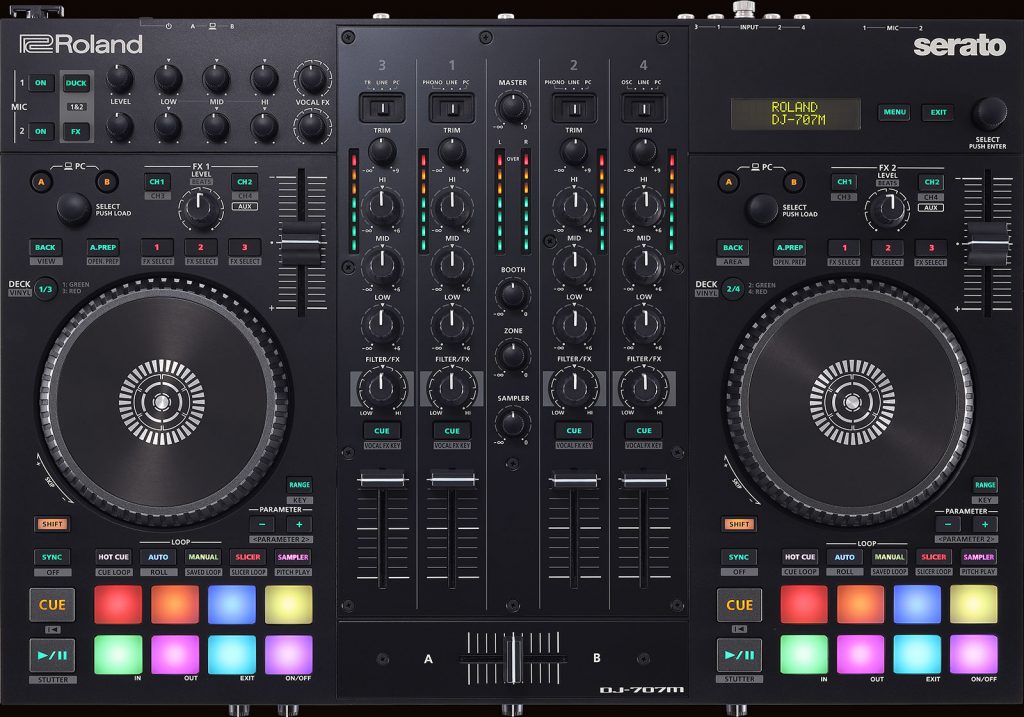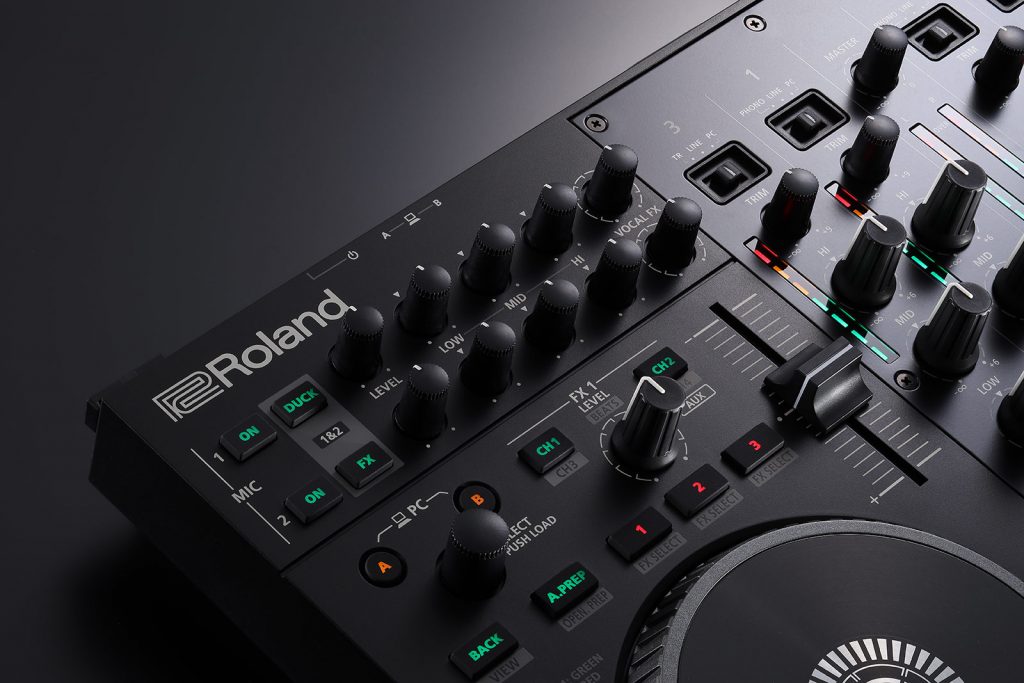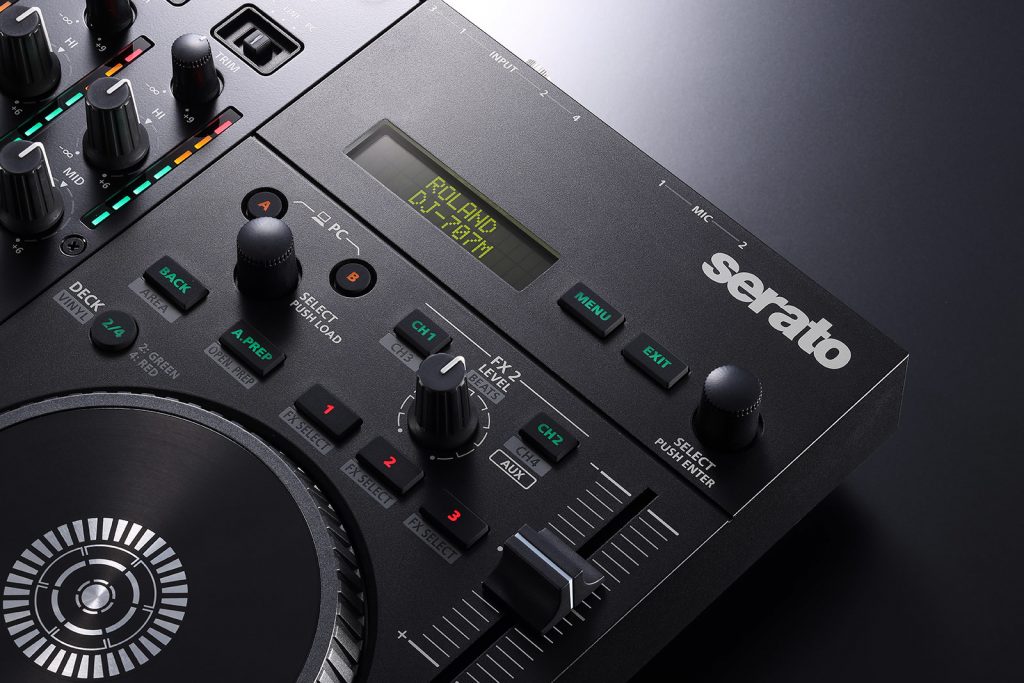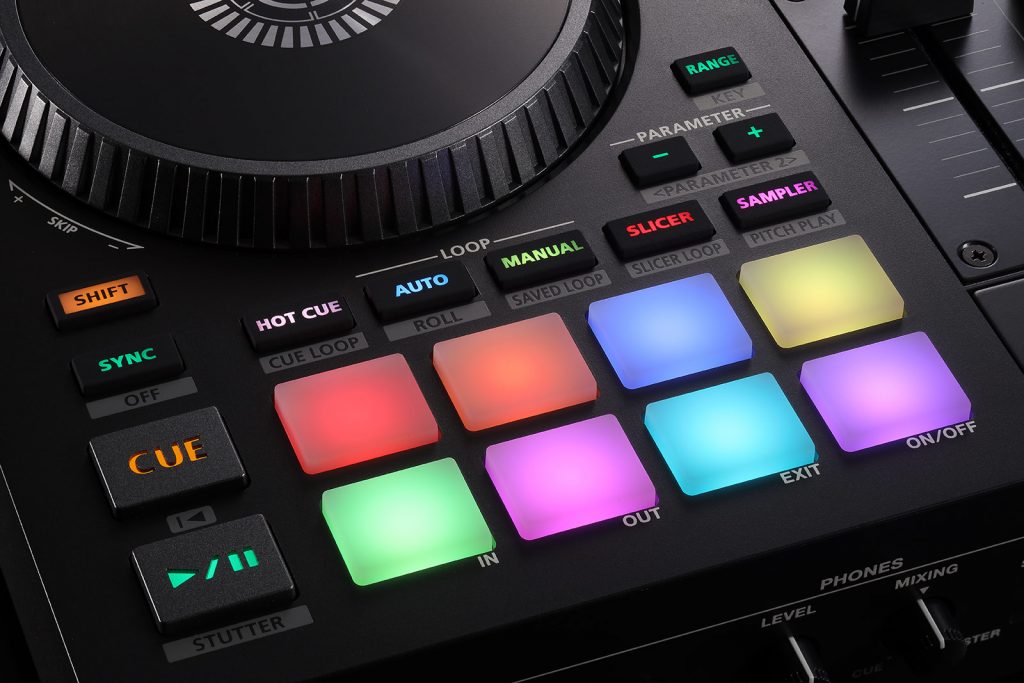Roland DJ return and for once it’s not all about the drum machines…
Roland are back with a brand new DJ controller and this time they are taking aim at one specific market, mobile DJ’s. Is this controller the ultimate for DJ’s carrying their own gear to parties, or is there more to this controller than first meets the eye? Let’s find out!
The Hardware
With the M in the model name referring to “Mobile” it’s no surprise to find that the 707M is a small, lightweight controller. Primarily of plastic construction to keep the weight down, it only uses metal in its build where absolutely necessary such as on the mixer face plate . Don’t let this worry you though, Roland haven’t built a controller that won’t last. A big part of mobile DJ’ing is surviving the transport and heavy work loads and the fully serviceable mixer section of this controller is a great example of how Roland have built this controller with longevity in mind.

When designing this controller Roland worked closely with mobile DJ’s from around the world and its shown in the final build. Features such as needle position indicators on the jog wheels aren’t of importance to most party DJ’s, so they are gone. As are long throw pitch faders and individual effect parameters. Other performance based features such as slip mode and key lock lack dedicated controls. The buttons making way to ensure this four channel controller has one of the smallest footprints we have ever seen. These decisions don’t feel like draw backs however, they have all been done with careful selection and to the target market, it’s well thought out. Mobile DJ’s won’t often be scratching, key shifting and remixing songs on the fly, so why waste valuable space on those features?
The Mixer
When it comes to mobile DJ’s it’s all about adapting to different situations. Each gig has the potential to be different, so having a wealth of inputs and outputs is paramount to adapting. The DJ 707M controller does not disappoint in this area, impressing with its versatility for such a small controller.
The DJ 707M features four line inputs and two phono inputs for external decks. Two dedicated XLR microphones with anti feedback plus built-in effects derived from Roland’s VT Vocal Transformer are also found to the rear. The auxiliary section on the front of the unit adds a further two TRS inputs and a 3.5mm stereo aux. Brilliant for adding in instrumentalists or further mics.

This amount of inputs is staggering and allows for some amazing set ups situations. Especially when the instrumentalists or microphones don’t take over the 4 channels on the mixer like on the Pioneer SX3. You can use the phono inputs on the mixer for Serato DVS but you will need the expansion pack which is sold separately to activate this feature.
Outputs are also comprehensively covered with Independent Master on XLR and RCA connections. A booth output on TRS jacks and a dedicated Zone output on RCA’s. The zone output can be set to output different music to separate speakers, for dedicated volume control over specific speakers (such as a subwoofer) or for sending independently cued mix to an external source such as recording or videographer. There is also a MIDI out should you wish to sync the onboard drum machine to other instruments.

Many mobile DJ’s carry a small PA mixer to gigs to tweak the sound of the mics and music to suit the speakers at any given gig. Roland have noted this and created a solution that solves this on the controller its self. Each output has its own separate EQ and multi band compressor which can be set via the onboard screen. You can save these settings into 10 different scenes, recalling specific set ups for different gigs. It’s like carrying three different processors to each gig, a massive selling point for those who take their sound quality seriously.

The Decks and Performance Features
The controller can be assigned to control all four Serato decks on either of two laptops with dual USB ports found on the rear. With portability taking precedent over performance, it’s no surprise to see the DJ 707M have smaller capacitive jog wheels and short throw pitch faders.
However not all performance aspects have been removed from the controller. 8 RGB performance pads remain at the bottom taking control over the usual host of Serato effects. Hot cues, auto loops, rolls and sampler are all found here with more advanced features such as pitch play found on the second layer, accessed by holding shift. Serato’s inbuilt effects can be activated via the three on/off buttons and are controlled by a singular wet/dry knob. The mixer contains an effects knob on each channel which can be assigned to a range of hardware effects. These include Filter, Dub Echo, Jet, Noise, Reverb, Delay, Bit Crush, Phaser, Noise 2, and more.

Being a Roland controller, it really would break the mould if it didn’t feature a drum machine. The target audience however probably won’t use such a feature very often. As such Roland have moved the drum machine to sit under channel 3. It’s nice to see Roland staying true to their values and it could prove useful for some scenarios. Adding a layer or classic 808 or 909 drums under an instrumentalist plugged into the controllers auxiliary section. The unique Roland sounds don’t stop there however. Tucked under channel 4 is a dedicated OSC allowing DJ’s to add sweepers, synth stabs, and other onboard sound effects to a mix. Again, not a feature many will use often but it’s great to see such features included on this portable controller.
The Verdict
The Roland DJ 707M is a masterclass of what can be achieved with limited space. Sitting just wider than most two channel rivals its size zero build is very impressive. However there are drawbacks from the diet that the controller been on. All the ingredients for a performance powerhouse of a controller are certainly there. But its cramped layout and lack of space will hinder the more energetic of DJs.
However that is not a major issue, because the DJ 707M was never built to be at the hands of a scratch DJ or even a club DJ for that matter. Roland built this controller for a single market. One with specific needs and one thats been grossly overlooked given its size.
There are more mobile DJ’s than there are club DJ’s in this world. There are more weddings, birthdays and private parties each weekend than there are club events. So why has it taken this long for a controller to come along that addresses their specific needs?
Who knows. All we know is, the Roland DJ 707M is going to sell very well indeed as it’s a mobile DJ’s dream come true.
RRP £879
Video Review
Our best suited courses for the Roland DJ-707M

Pioneer DDJ SB3 DJ Course
3.75 hours
28 lessons
Beginner

Serato DJ Course
3.5 hours
23 lessons
Beginner

Serato DJ Course
8.5 hours
47 lessons
Intermediate

Pioneer DJ DDJ-FLX4 Course
7 hours
41 lessons
Beginner

Complete DJ Package
835 hours
1300+ lessons
Creative

Pioneer DJ DDJ-FLX4 Pro Course
9.5 hours
49 lessons
Intermediate

DDJ FLX4 Beginner To Pro Bundle
16.5 hours
90 lessons
Beginner








the faders feel good.. ay and cue could be a little.more clicky and less mushy. would be nice if they were raised too. it does feel a little cramped having migrated from a Traktor S2 MK2, but I am pleasently surprised with the jogs, which are really responsive and although smaller than the s2’s, are easier to scratch with as they dont drift and loose their place easily. looking forward to doing more with this lil beaut.